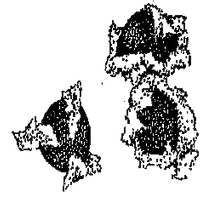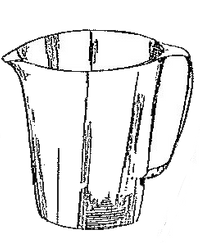- How Concerned Should I Be That Lead May Contaminate Urban Gardens?
- Book Review: Future Fertility: Transforming Human Waste into Human Wealth
- Moringa Seeds Used in Water Purification
- Using Moringa on a Larger Scale
- A Living Fence that Might be Deadly
HOW CONCERNED SHOULD I BE THAT LEAD MAY CONTAMINATE URBAN GARDENS? This question was asked by Craig Shuck with World Concern. I spoke with Dr. Nina Bassuk, the program director of Cornell University's Urban Horticulture Institute and asked her to give us a perspective on this question. There are two situations where lead may be a problem: (1) if you are gardening near a busy highway and (2) if you are planting in the rubble of a building in which lead paint had been used. Of the two, the second is the more serious. Dr. Bassuk said that there is no reason to panic over the question. If your entire diet is not from such a garden and children are over 6 years old, there is no reason for real concern. There would be some concern for children under 6 for whom a large portion of their diet came from a lead contaminated garden. However, if they play in the area, the hand to mouth ingestion of lead is far more serious. Plants naturally exclude most of the lead. She believes that contamination by cars would only be a serious problem for gardens planted quite close to cars on a busy highway.
She has developed a "cure" for such soils, based on experiments from urban gardens in New York City. The cure calls for adding large amounts of organic matter such as compost or manure and maintaining the pH near neutral. In soils containing large amounts of lead, organic matter representing at least 25% of the total volume may be needed. Lettuce grown in soils with 40-50% organic matter had zero lead uptake, even though the concentrations in the soil were as high as 3,000 ppm. The organic matter is more effective if it is well decomposed. When the pH drops below 6.0, the level of lead uptake increases. [However, that much organic matter should itself help buffer the pH.] Adjusting the pH to levels >6.5 is also effective against cadmium, another toxic heavy metal.
Leafy and root crops such as lettuce, spinach, potatoes and beets are likely to absorb lead. Crops grown for seed or fruit such as corn, tomatoes, beans, squash, eggplant and peppers normally do not absorb lead from soil in any appreciable amount. In spite of organic matter in the soil, plants near a busy highway can still become contaminated as lead from exhaust is deposited directly on the leaves. Water removes only a small amount of the lead, but 1% vinegar added to the water or 0.5% dishwashing liquid removed it effectively.
FUTURE FERTILITY: Transforming Human Waste into Human Wealth by John Beeby addresses a question many development workers face. "The soil here is so depleted and so few inputs are available. Is it safe to recycle human waste into our fields or gardens?" This book takes a careful look at the topic of processing human urine and manure so it may be safely  added to the soil to sustain productivity. For those of you in areas where human waste is currently unmanaged and causes the spread of disease, this book may be very helpful in defining treatment options you could implement. Nine different methods for recycling manure (aquaculture, algae, solar heating, composting, trees, grains, etc.) are outlined and compared based on purification levels, resources required, and the value of the finished product as fertilizer. This book will answer many of your questions about how to manage a waste recycling system safely and effectively. The 164-page book is US$18.50 plus postage ($4.50 within the USA; others write for exact cost) from: Bountiful Gardens, 18001 Shafer Ranch Rd., Willits, CA 95490-9626, USA.
added to the soil to sustain productivity. For those of you in areas where human waste is currently unmanaged and causes the spread of disease, this book may be very helpful in defining treatment options you could implement. Nine different methods for recycling manure (aquaculture, algae, solar heating, composting, trees, grains, etc.) are outlined and compared based on purification levels, resources required, and the value of the finished product as fertilizer. This book will answer many of your questions about how to manage a waste recycling system safely and effectively. The 164-page book is US$18.50 plus postage ($4.50 within the USA; others write for exact cost) from: Bountiful Gardens, 18001 Shafer Ranch Rd., Willits, CA 95490-9626, USA.
MORINGA SEEDS USED IN WATER PURIFICATION. We learned of another use for the multipurpose tree Moringa oleifera from Dr. Samia Al Azharia Jahn with the Deutsche Gesellschaft fur Technische Zusammenarbeit (GTZ) in Germany. Suspensions of the ground seed of the moringa tree are used as primary coagulants to clarify Nile water. At high turbidities their action was almost as fast as that of alum, and at medium and low turbidities >30 FTU it was comparable with the optimum dose and proper stirring technique. The doses required did not exceed 250 mg/l.
Coagulating the solid matter in water so that it can be easily removed can remove a good portion of the suspended bacteria. "River water is always faecally polluted. At our sampling site the total coliforms amounted during the flood season to 1600-18,000 per 100 ml. Turbidity reductions to 10 FTU were achieved after one hour, reducing the coliforms to 1-200 per 100 ml. Good clarification is obtained if a small cloth bag filled with the powdered seeds of the moringa is swirled round in the turbid water." "With raw water turbidities below 30 FTU no satisfactory removal of suspended matter can be achieved unless the seed suspension is used in combination with alum."
The material can clarify not only highly turbid muddy water but also waters of medium and low turbidity which may appear milky and opaque or sometimes yellowish or greyish (showing annual turbidity fluctuations between 50-300 FTU, such as the White Nile or several African lakes). During the cool season, complete clarification, which takes only one hour in warmer water, may take two hours unless the water is left in the sun for some time to raise its temperature."
 The number of seeds required for treatment depends on the local average weight of their white kernels, found to range from 130-320 mg in different clones. "In the case of the Blue Nile, for example, water of low turbidity in the initial and final flood season needs doses equivalent to about one quarter of a 200 mg seed per liter, water of medium turbidities needs half a seed per liter and at high turbidities the dose should be 1-1.5 seeds per liter." Water from a different river will require different quantities of clarifier because of variable characteristics of suspended material. Simple experiments in a jar will determine the best dose.
The number of seeds required for treatment depends on the local average weight of their white kernels, found to range from 130-320 mg in different clones. "In the case of the Blue Nile, for example, water of low turbidity in the initial and final flood season needs doses equivalent to about one quarter of a 200 mg seed per liter, water of medium turbidities needs half a seed per liter and at high turbidities the dose should be 1-1.5 seeds per liter." Water from a different river will require different quantities of clarifier because of variable characteristics of suspended material. Simple experiments in a jar will determine the best dose.
To prepare the seed for use as a coagulant, remove the seed coats and the "wings." The white kernel is then crushed to a powder, using a mortar or placing in a cloth on top of a stone and crushing. The powder should be mixed with a small amount of clear water (about a 2% suspension) in a small bottle. Close the bottle, then shake at least 5 minutes to obtain a good water extract. This milky extract is then poured through a tea strainer before being added to the turbid water. It is even better to put some thin clean wide-mesh cotton cloth on the strainer.
"The milky white suspension has to be added to the turbid water and stirred fast for at least one minute. If a wooden soup whisk is used, the nails sometimes present in these gadgets should be replaced by small wooden sticks. After that the floc will not form unless it is stirred slowly and regularly (15-20 rotations per minute) for about five minutes." "After stirring the treated water should be covered and left to settle for at least an hour." If moved or shaken before then, clarification will take much longer or fail to reach completion. The GTZ is planning implementation projects in Indonesia and Kenya. Dr. Jahn has retired, but you may still write her at GTZ, Abt. 414; Postfach 5180; D-65726 Eschborn, GERMANY.
Dr. Samia Al Azharia Jahn has written a 539-page book, Proper Use of African Natural Coagulants for Rural Water Supplies. (Chapter titles: Annual fluctuations in raw water quality, Water treatment with traditional plant coagulants, Special microbiological and toxicological studies on water purification, Cultivation of moringa trees, Introducing domestic water treatment to rural people, Practical guide to domestic water coagulation and hygienic water storage). Much of the book is devoted to moringa. French and Spanish translations are in preparation. The book may be available from the Deutsche Gesellschaft fur Technische Zusammenarbeit (GTZ) at the address above; fax 06196-79-73-17. Dr. Jahn has sent us seed for two related, more drought-tolerant species which, if we get them to produce, we will offer to you. Dr. Jahn would like to hear from you if you are working with moringa in a major way.
She also sent us an article from the East African Medical Journal that investigated whether water treated with moringa seed powder might be toxic to people. Pounded seeds were fed to rats for 6 weeks with no toxic effects. "As the plant material acts as a flocculent [makes solids come together and settle], one might assume that most of it will get trapped in the sediment and only easily dissolvable substances will be present in the water." Furthermore, moringa "seeds are used for food; they are roasted like peanuts, pounded for tea and curries are prepared from the green pods." [I have not heard of the mature dried seeds being eaten, and at least the variety we have is quite distasteful, so I wonder if these food uses are not all for green seeds.]
as a flocculent [makes solids come together and settle], one might assume that most of it will get trapped in the sediment and only easily dissolvable substances will be present in the water." Furthermore, moringa "seeds are used for food; they are roasted like peanuts, pounded for tea and curries are prepared from the green pods." [I have not heard of the mature dried seeds being eaten, and at least the variety we have is quite distasteful, so I wonder if these food uses are not all for green seeds.]
Dr. Mike Benge with the forestry department of AID has put together a 196-page photocopied compilation on moringa which he titles "Moringa: a Multipurpose Vegetable and Tree That Purifies Water." He wrote, "If you have people who would like this kind of information, just send their addresses." You should contact him at Agroforestry, G/ENV, Rm. 413-E, SA-18, Agency for International Development, Washington, D.C. 20523-1812, USA; phone 703/875-4063; fax 703/875-4639; e-mail mbenge@usaid.gov.
USING MORINGA ON A LARGER SCALE. Use of moringa seed on a small scale (household level) to purify water has been mentioned. Dr. Geoff Folkard at the University of Leicester in England sent us articles concerning recent work in Malawi. "This is the first time that Moringa oleifera seed has been used as a primary coagulant [to clarify water in a treatment plant] at this scale (flow rate 16 m3 per hour)."
The water plant normally uses alum, an imported chemical, to clarify the water. They only had enough seed to run the plant six hours. Water quality was monitored before and after the switch from alum to moringa was made. There was no deterioration in performance. They used twice as much moringa as alum (50 mg/ml of moringa seed vs. 75 mg/ml).
Laboratory trials show that using alum and moringa together (they call it co-coagulation) can give superior results to either used alone. Moringa seed (either M. oleifera or M. stenopetala) was equivalent to alum and even superior in water of unusually high turbidity. (If you are interested in the chemistry involved, the active ingredients in moringa seed have been identified as two small water-soluble proteins with a net positive charge.)
"For many countries, imported alum is the major cost element in the provision of potable water. Malawi currently spends in excess of œ220,000 each year on imported alum. Switching to moringa would both save foreign exchange and generate farm and employment income.
"Further full scale trials in Malawi are planned for January 1994. It is hoped that demonstrations for interested parties from other developing countries will be arranged." Dr. Folkard's address is University of Leicester, University Road, Leicester LE1 7RH, England. Write him for his 1995 technical reports if you have serious interest in large-scale water treatment.
Dr. Folkard is now working on extracting the oil from moringa seed. Preliminary tests indicate that the cake remaining after the  oil is extracted is still able to clarify water. He is conducting further tests. Because the oil is quite valuable, this could have a big impact on the economic viability of a moringa-based water treatment program.
oil is extracted is still able to clarify water. He is conducting further tests. Because the oil is quite valuable, this could have a big impact on the economic viability of a moringa-based water treatment program.
A LIVING FENCE THAT MIGHT BE DEADLY? The following is based on a note in the October-December 1991 issue of Agroforestry Today, which in turn is based on an article in The Economist (July 6, 1991 pp 86-87) and The Lancet (May 30, 1987 pp 1257-58).
"Farmers near Kabale in Kenya describe traditions, now considered superstitious, that certain euphorbias cause cancer when planted near the homestead." [Euphorbias in Africa fill many of the environmental niches that are filled by cacti in the Americas.] Now the carcinogenic effects of one common living fence species, Euphorbia tirucalli, have been described. The active carcinogen has been found not only in the plant itself, but in extracts from nearby soil, vegetables and drinking water. "The report suggests that Burkitt's lymphoma, a common childhood cancer in East Africa, is caused in part by consumption of water and vegetables from sites near this euphorbia." The plant grows profusely in Kenya's Eastern, Western and Nyanza Provinces and in parts of Tanzania. In southwestern Uganda it is widely planted as a living fence to exclude livestock from protected springs, suggesting the frightening prospect that water that has been assumed safe is in fact very hazardous. It is also commonly used as a living fence to protect food crops.